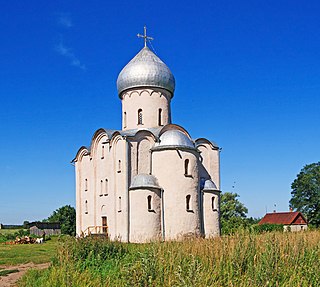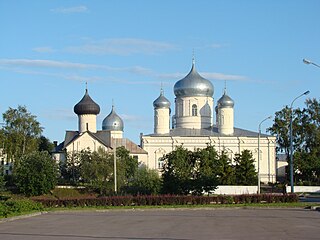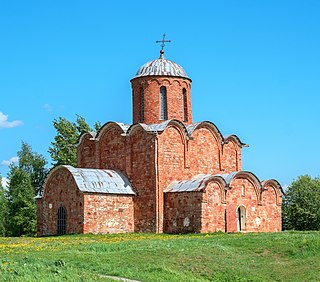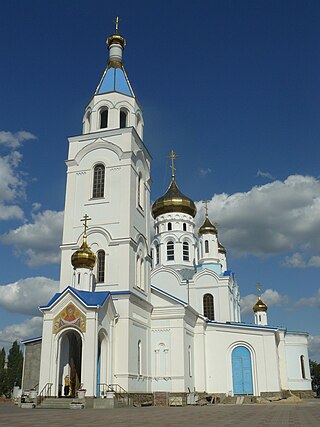
The Saviour Church on Nereditsa Hill near Novgorod is a 12th-century Orthodox church dedicated to the feast of the Saviour's Transfiguration.

The Zverin Monastery is a monastery in Veliky Novgorod, located on the left bank of the Volkhov River, north of the Kremlin. This is one of the oldest Russian monasteries, founded before the 12th century.

The Church of Saint Peter and Saint Paul in Sinichya Gora (‹See Tfd›Russian: Церковь Петра и Павла на Синичьей горе, romanized: Tserkov Petra i Pavla na Sinichyey Gore) in Veliky Novgorod is one of Russia's oldest churches, dating from 1192. The church is located at Saint Peter Cemetery, on the left (Sofiysky) bank of the Volkhov River, outside of the limits of the old city.

The Church of the Nativity of the Theotokos on Peryn (‹See Tfd›Russian: Церковь Рождества Богородицы на Перыни, Tserkov Rozhdestva Bogoroditsy na Peryni) in the environs of Veliky Novgorod is one of the region's oldest churches, dating from the 1220s. The church is located 6 kilometres (3.7 mi) from Veliky Novgorod, by the source of the Volkhov River where it flows out of Lake Ilmen. The church is a part of the Peryn Skete, a former monastery abolished in the 18th century, and is the only functioning church in the complex.

The Transfiguration Church in Kovalyovo in Novgorodsky District, Novgorod Oblast, Russia, was built around 1345. The church was notable for the frescoes created in the 14th century. The church was destroyed to the ground during World War II and restored in 1970. Fragments of the frescoes have since been reconstructed. The church is located 4 kilometres (2.5 mi) east of Veliky Novgorod, on the right bank of the Maly Volkhovets River. The Transfiguration Church in Kovalyovo was designated an architectural monument of federal significance (#5310100000).

Transfiguration Church of the St. Euphrosine monastery in Polotsk, Belarus is a unique monument of Pre-Mongol Rus architecture. Built in the 12th century, it was reconstructed in the 17th and the 19th centuries. Despite the reconstructions, the church has preserved the original Medieval frescoes.

Dormition Cathedral in the selo of Staraya Ladoga, Volkhovsky District, Leningrad Oblast, Russia is one of the oldest churches of Russia, dating from the second half of the 12th century. It is one of the few surviving pre-Mongol buildings in Russia, and the northernmost one. The cathedral is the katholikon of the female Dormition Monastery, one of the several monasteries in Staraya Ladoga, and is located on the left bank of the Volkhov River. The building was designated an architectural monument of federal significance (#4710028015).

Akinfiyevo – is a village in Nizhnyaya Salda urban district of Sverdlovsk Oblast. Population: 218

The Annunciation Greek Orthodox Church‹See Tfd›Russian: was a Greek Orthodox church constructed in 1909 in Rostov-on-Don. In Soviet times, the church was demolished, and the Puppet Theatre was built on its foundations. A new Greek church of the Annunciation was built close to the site of the demolished one in 2014.

Church of the Assumption is a Russian Orthodox church in the village of Nedvigovka, Rostov Oblast, Russia. It belongs to the Diocese of Rostov and Novocherkassk. Erected in the early 20th century, it is considered to be an object of Russian cultural heritage.
Orthodox churches in Rostov-on-Don were built during the 17th–20th centuries; they played a role in shaping of the architectural appearance of Rostov-on-Don. They created the high-altitude dominants.

The Church of the Nativity of the Blessed Virgin Mary is a Russian Orthodox church in Konygin khutor, Ust-Donetsky District, Rostov Oblast, Russia. It was built in 1879 and belongs to Ust-Donetskoe deanery of Volgodonsk Diocese. It is also the oldest church in Ust-Donetsky District, which has been preserved to the present day.

The Church of the Intercession of the Holy Virgin was a Russian Orthodox church in Elizavetinskaya stanitsa, Rostov Oblast, Russia.

The Cathedral of the Intercession of the Holy Virgin is a Russian Orthodox cathedral in Shakhty, Rostov Oblast, Russia that belongs to the Diocese of Shakhty and Millerovo and was built in 1902.

Church of the Assumption of the Blessed Virgin Mary in the Trinity-Lykov is an Orthodox church of the Assumption deanery of the Urban Diocese of Moscow. It was built in the 1840s-1850s in the village of Troitsa-Lykovo near Moscow. The main throne is consecrated in honor of the feast of the Assumption of the Blessed Virgin Mary, lateral chapels - in honor of the Great Martyr Catherine and Nicholas the Wonderworker. The temple is a courtyard of the Intercession Monastery. It has the status of an object of cultural heritage of regional importance.

Church of the Intercession of the Most Holy Mother of God is an Orthodox church in Kamensk-Uralsky, Sverdlovsk oblast.

Church of the Intercession of the Most Holy Mother of God - is an Orthodox church in Kamensk-Uralsky, Sverdlovsk oblast.

Church of the Purification of the Blessed Virgin Mary - is an Orthodox church in Staropyshminsk village, Sverdlovsk oblast.

The Annunciation Church of the Alexander Nevsky Lavra, or in full, the Church of the Blessing of the Most Holy Virgin and the Holy Blessed Prince Alexander Nevsky is a Russian Orthodox church in Saint Petersburg. It is in the Diocese of Saint Petersburg and is part of the Alexander Nevsky Lavra.

The Church of the Theotokos of the Sign (Dubrovitsy), or The Church of the Holy Sign of the Mother of God in Dubrovitsy, (‹See Tfd›Russian: Церковь Зна́мения Пресвятой Богоро́дицы в Дубровицах) is a Russian Orthodox church in the village of Dubrovitsy, Podolsk Urban Okrug, Moscow Oblast, Russia. Dubrovitsy is located about 36 km South of Moscow (16 km from the Moscow Ring Road; along the highway Podolsk-Dubrovitsy 6 km). The Dubrovitsy Estate used to belong to the noble families of Morozov, Golitsyn and Dmitriev-Mamonov. The estate consists of a palace, a Horse yard with Gothic gate, several outbuildings, a church and a park. The church is famous for its unique architecture, unusual to Russian architecture, as well as a mysterious history.





















